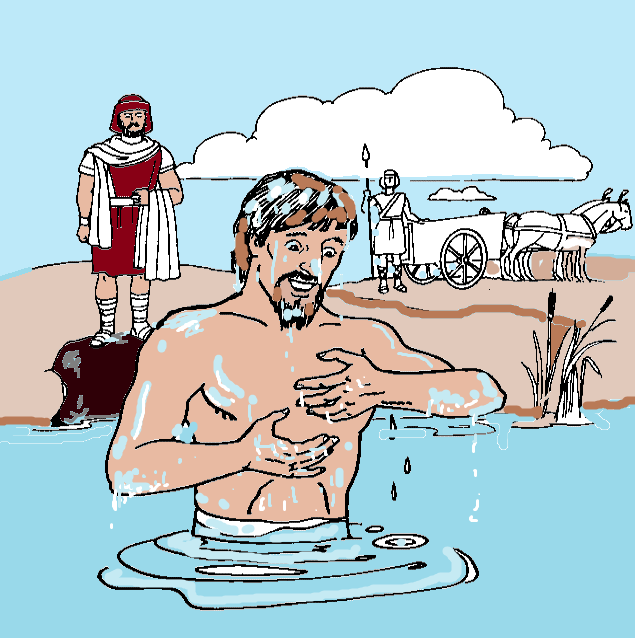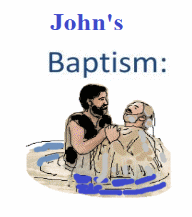 John
Was God’s Prophet.
Whereas
the elders
added their traditions to
the Law which
were condemned
by Jesus, the baptism of John was added by God’s
authority.
John
was not just a Levite; he was God’s prophet.
John
Was God’s Prophet.
Whereas
the elders
added their traditions to
the Law which
were condemned
by Jesus, the baptism of John was added by God’s
authority.
John
was not just a Levite; he was God’s prophet.
LEAVING THE DOCTRINE OF BAPTISMS #7
WHY DID JOHN BAPTIZE? -I
BASIC TEXT: “Therefore leaving the [first, Heb. 5:12] principles of the doctrine of Christ, ... Of the doctrine of baptisms” (Hebrews 6:1, 2, KJV)
The Hebrew writer in advising the reader to “leave the [first principles] doctrine of baptisms” includes the Temple system’s baptisms (Hebrews 6:1,2; 9:8-10). The book of Hebrews is thought to have been written just before 70 AD, the year that the Temple in Jerusalem was destroyed by the Roman army. The writer refers to the Temple system as an existing practice. He is probably anticipating that terrible day of destruction in Hebrews 10:25 “as you see the day approaching.” Jesus prophesied that not one stone of the temple would be left upon another (Matthew 24:2). Titus’ army did demolish the Temple in that way.i
The writer refers to a Covenant that is “ready to vanish away” (Hebrews 8:13). The destruction of the Temple was certainly the death knell of the sacrificial system. Approximately 40 years prior to this writing, a son of a priest had appeared in “raiment of camel's hair, and a leathern girdle” in the wilderness of Judea preaching of the advent of the promised “kingdom of heaven” (Matthew 3:2; cf. Daniel 2:44). He was baptizing repentant Jews in water (Matthew 3:11) in anticipation.
What was the meaning and difference of the baptism of John “the Immerser”?
When we think about John’s baptism, the temple (or tabernacle) washings come to mind; i.e., the baptisms authorized by God under the Old Testament (fifteenth century BC) and probably even the various washings added by the Jewish “intertestamental” elders of the post-Babylonian-captivity (5th century BC). Jesus condemned the latter.
Let’s then compare John’s washing to the authorized Temple consecration and purification practices. It is proper to do so because the Holy Spirit refers to the temple system as figures [parables] for the New Testament (Covenant): “Which was a figure for the time then present” (Hebrews 9:8-10); also “an example” (a copy; a pattern) and “shadow of heavenly things to come in Christ” (Colossians 2:17; Hebrews 8:5; 9:23).
John Under The Law Of Moses. Jesus was contemporary to John being born a few months after John, but Jesus was under the Law. According to Galatians 4:4 “When the fulness of the time came, God sent forth his Son, born of a woman, born under the law.” Both Jesus and John were born under the Law of Moses. Mary the mother of Jesus observed that Law. “And when the days of their purification according to the law of Moses were fulfilled, they brought him up to Jerusalem, to present him to the Lord” (Luke 2:22). Jesus during His ministry also taught the Law of Moses. A lawyer tested Jesus. ‘"Teacher," he asked, "what must I do to inherit eternal life?" "What is written in the Law?" he replied. "How do you read it?" He answered: "Love the Lord your God with all your heart and with all your soul and with all your strength and with all your mind' and, `Love your neighbor as yourself”’ (Luke 10:25-27; quoted from such passages as Deuteronomy 6:5, 10:12 and Leviticus 19:18, etc.).
Self immersion
 John
Was God’s Prophet.
Whereas
the elders
added their traditions to
the Law which
were condemned
by Jesus, the baptism of John was added by God’s
authority.
John
was not just a Levite; he was God’s prophet.
John
Was God’s Prophet.
Whereas
the elders
added their traditions to
the Law which
were condemned
by Jesus, the baptism of John was added by God’s
authority.
John
was not just a Levite; he was God’s prophet.
“And all the people that heard him, and the publicans, justified God, being baptized with the baptism of John. But the Pharisees and lawyers rejected the counsel of God against themselves, being not baptized of him” (Luke 7:29,30).
David was one of the prophets. As a prophet, he added a Levite choir and Levite instruments to the worship for the Temple (2 Chronicles 29:25). Just as the prophet Elisha added the command for Naaman to baptize himself 7 times for healing from leprosy, John in the capacity of prophet commanded the new requirement for all Jews to be baptized. Jesus said about John, “Really, what did you go out to see? A prophet? Yes, I tell you, and even more than a prophet!” (Matthew 11:9). John was a prophet of God.
Jesus says the prophecies of the Law (Torah) and Prophets (the rest of OT) targeted (pointed to) John as God’s Special One who was coming as the Lord’s harbinger and spokesman. “For this is he, of whom it is written” (Matthew 11:10; e.g., Malachi 3:1; 4:5; Isaiah 40:3, etc.).
 Why
John Was Called “The
Baptizer.”
John
personally
immersed
the recipient. Hence,
he was called
“the”
immerser; i.e.,
“the Baptist”.
But was he the only one that immersed the people?
The
answer is “yes” initially
because
Jesus’ disciples immersed later
as
well (John 4:2). John’s
action was new. Only the priests were so dealt with
(i.e.,
if we accept that the whole
body bathing
of the priests was immersion).ii
Therefore,
John was known as the Immerser.
Why
John Was Called “The
Baptizer.”
John
personally
immersed
the recipient. Hence,
he was called
“the”
immerser; i.e.,
“the Baptist”.
But was he the only one that immersed the people?
The
answer is “yes” initially
because
Jesus’ disciples immersed later
as
well (John 4:2). John’s
action was new. Only the priests were so dealt with
(i.e.,
if we accept that the whole
body bathing
of the priests was immersion).ii
Therefore,
John was known as the Immerser.
The passiveiii form for John’s baptism of the candidate was different from that of the public’s purification baths. The Jews were acquainted with the purification self-immersions required for tabernacle/temple worship and service (both the Scriptural authorized ones and the added home traditions by the elders). As you recall, Jesus was condemned for not immersing (baptizoG907) himself after traveling and before his eating (Luke 11:38). Meyer says: “Before eating they [Jews] wash the hands always. When they come from market they take a bath before eating.”iv The complete body immersions for such purification cleansings were always self-induced.
OT Baptism: A Pattern Of Heavenly Service. The Law provided for a person to immerse another in water if that candidate was being consecrated as a priest. Even a circumcised Jewish proselyte would have to baptize himself.v As to a pattern or parable, John’s baptizing could only be identified with the unique consecration of the sons of Aaron (Exodus 29:1, 4; Leviticus 8:6) for tabernacle service. So John’s baptism in this sense would be preparation for the true tabernacle service (Hebrews 8:2). Recall that Jesus is the true High Priest who would be entering into the true Holy of Holies (Hebrews 9:24).
John Begins Work At Age 30. One would expect John to be baptized himself at this time as a priest.vi He was qualified to work at the Temple since he was a descendant of Aaron, the son of the priest Zechariah (Luke 1:8-11; 1 Chronicles 24; Luke 1:5f)vii According to Numbers 4, a Levite was appointed to regular service at the temple at the age of 30.viii But at age 30, John begins work, not in Temple service, but preaching and baptizing in the wilderness of Judea.
Some questions for next article to consider:
1. What were all the purposes of John’s baptism?
2. Why was Jesus baptized?
3. Did John’s disciples (including Jesus’ apostles) have to be re-baptized after Pentecost?
i The so called “W ailing Wall” that exists today was not a wall of the Temple; rather, it was a retaining wall for the elevated Temple Mount (Moriah). http://www.jewishvirtuallibrary.org/history-and-overivew-of-the-western- wall
ii Immersion? “ Some Jewish interpreters have maintained that the washing of Aaron and his sons was by immersion, as was required of the high priest on the day of atonement (Leviticus 16:4).” (Harrison). https://biblehub.com/commentaries/guzik/commentaries/0308.htm
iii passive: “acted upon by an external agency” (Merriam-Webster Dictionary ).
ivHeinrich Meyer's Critical and Exegetical Commentary on the New Testament, quoted in Mark 7:4. Robertson’s Word Pictures. My comment: Past commentators, ignorant of this rite, wanted to restrict the practice to baptizing only the hands.
vhttps://soundfaith.com/sermons/37029-jewish-proselyte-baptism
The Babylonian Talmud says "one is not to be regarded as a proselyte until he has been circumcised and undergone immersion, and as long as he has not undergone immersion, he is still a non-Jew.” http://digitalcommons.butler.edu/cgi/viewcontent.cgi?article=1200&context=grtheses
“Then the convert made a complete immersion and stepped forth as a fully privileged Israelite.” Encyclopedia of Religion and Ethios, Hastings, Vol. 2, p. 408. http://digitalcommons.butler.edu/cgi/viewcontent.cgi? article=1200&context=grtheses.
vihttps://biblehub.com/commentaries/guzik/commentaries/0308.htm
viihttps://en.wikipedia.org/wiki/Zechariah_(priest)
viiiThis age was either lowered to 25 (Numbers 8:4) and later to 20 (1 Chronicles 23:24) or tutoring began then as the rabbinical teachings later taught.

|